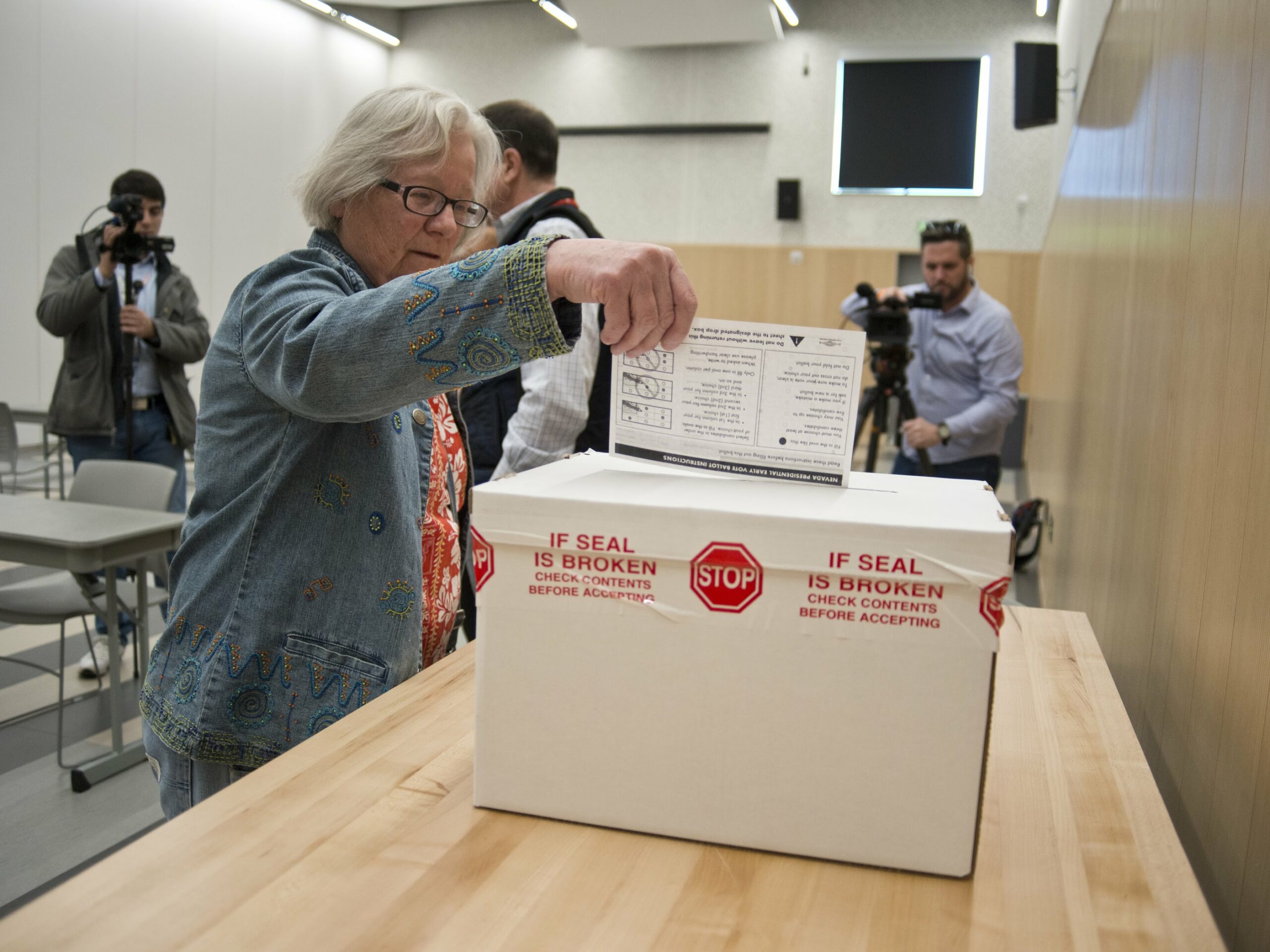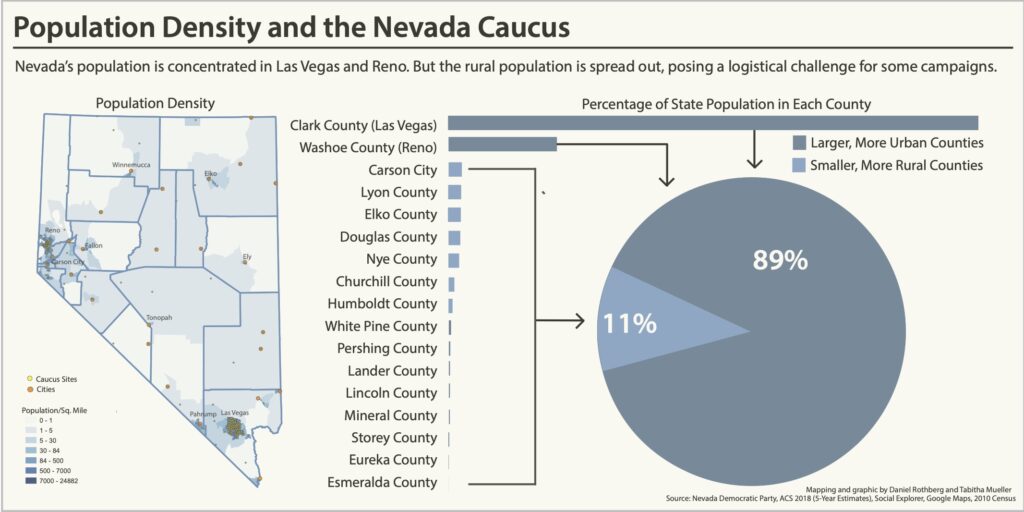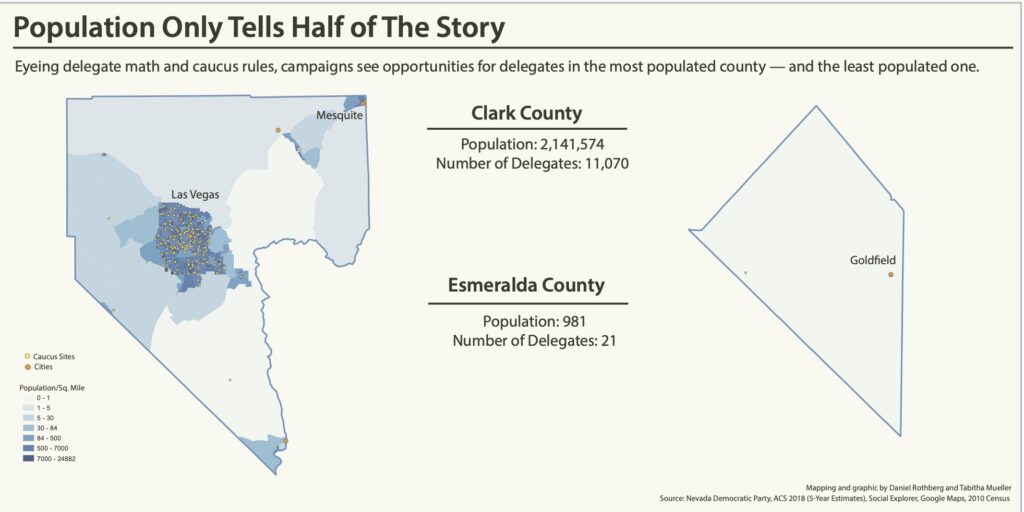The geography of the Democratic caucus and why some campaigns are rallying supporters in rural Nevada

A speech in Reno might reach thousands of voters all at once. A television ad buy in Las Vegas’s media market might reach even more. But sometimes it still pays to hit the ground.
Nevada is a unique state.
By total state population, Nevada is ranked as one of the least rural states. About 90 percent of the state’s total population lives in two counties, Clark and Washoe, that comprise a fraction of the state’s land mass. And the vast majority of Nevada residents live in Las Vegas.
At the same time, the state’s smaller counties are some of the least populated rural areas in the country, according to U.S. Census data. The dynamic of having two large cities and several very rural towns scattered across the Great Basin, is a stark contrast to the first two Democratic primary states — Iowa and New Hampshire — where rural populations are more widespread.
In Iowa and New Hampshire, candidates and their staff are often on the ground, driving from town to town. But in Nevada, Las Vegas and Reno are separated by a seven-hour drive. Most campaigns get on a plane to travel between the state’s two largest metropolitan areas. With few Democratic voters between those two cities, the lengthy drive-time doesn’t always pencil out.
“Where the population centers are is where the cash cow of delegates are,” said Megan Jones, a campaign consultant who advised California Sen. Kamala Harris’ campaign earlier in the cycle. “There are definitely delegates in the rurals, but it's not the same as Iowa and New Hampshire.”

Ground games still matter
The rural counties might not get a lot of visits from candidates.
But they can make a difference in competitive races.
In 2008, then-Illinois Sen. Barack Obama, lost in total number of caucusgoers only to declare a victory in delegates because his campaign understood the dynamic of rural caucus delegates.
The rules that apportion delegates earned from caucus voting are based on the state’s congressional districts. At the time, a certain allocation of delegates had to come from rural areas. Understanding that, the Obama campaign targeted turnout in specific rural areas.
Since 2008, the state has added a congressional seat and selection rules have changed.
But there is still an incentive for candidates to go to rural Nevada.
“A lot of the campaigns are spending a lot more time than they have in the past in engaging the rural counties,” said Kimi Cole, who chairs the Douglas County Democratic Party and the Rural Nevada Democratic Caucus. "In a close race, you can't throw those votes away."
Several campaigns, especially those that have been knocking on doors in Nevada for months, believe that rural caucusgoers could drive up a candidate’s delegate count in a close contest.
Here’s what they see
Overall, there are fewer potential delegates in rural counties. But Nevada law, by ensuring that rural voters are included, apportions delegates differently and gives more weight to rural voters.
How this plays into a caucus strategy is complex, but it works like this.
The statute requires any major political party to apportion delegates to each election precinct in proportion with the total number of registered voters for that political party within that county.
There are eight tiers for apportioning delegates to precincts. What it means is that in counties like Clark County and Washoe County where there are more than 4,000 registered Democrats, each precinct receives one delegate for every 50 registered voters. But in the most rural areas — in counties with only 400 Democrats — each precinct gets one delegate for every five voters.
In this, there is an advantage for campaigns.
Take a hypothetical five-delegate precinct in Clark County, with about 500,000 Democrats, and compare it to a five-delegate precinct in Esmeralda County, with about 100 Democratic voters.
Because of how the caucus is structured, to win those five delegates in Clark County would require many more supporters to turn out, competing heavily with other campaigns that have actively invested in turning out voters in Las Vegas. But to win all five delegates in Esmeralda County might only require five voters to show up. The issue is reaching those county’s voters.

And that’s where the ground game comes in.
Multiple presidential candidates have invested heavily in outreach in Nevada. Mayor Pete Buttigieg’s campaign has field offices in Elko, Pahrump and Fallon. Buttigieg visited Elko during early voting, where he also did an interview with the Elko Daily Free Press. The former South Bend mayor also campaigned in Salt Lake City this week. Although Utah’s primary is not until March 3, Super Tuesday, the Salt Lake City media market reaches northeastern Nevada.
Buttigieg is not alone. Other candidates have actively courted voters in northeastern Nevada. Vermont Sen. Bernie Sanders and Massachusetts Sen. Elizabeth Warren both have offices in Elko. In addition to Buttigieg, Sanders and former Vice President Joe Biden have visited Elko.
Minnesota Sen. Amy Klobuchar is scheduled to speak in Elko on Friday, a day before the caucus.
In 2016, Sanders won Elko County, along with most of the northern half of the state, with many of the southern counties supporting Secretary of State in Hillary Clinton. In 2008, most northern counties swung for Obama while counties in the southern half of the state backed Clinton.
Looking toward the convention
Campaigning in the rurals could also play a role after Saturday.
Nevada’s delegates to the Democratic National Convention are still allocated by congressional districts in a successive process starting with county — and then state — conventions. In order to accrue delegates from a congressional district, candidates need to perform across counties.
In the two Las Vegas congressional districts (1 and 3), this is not an issue because they are fully within Clark County. But in order to remain viable for delegates from Congressional District 2, spanning from Reno and rural northeastern Nevada, candidates must campaign in rural areas. The same is true of Congressional District 4, extending from Las Vegas through central Nevada.
In short, a candidate could outperform in Reno but not be viable if they have no Elko delegates.
But a big variable looms over the caucus, including how rural counties will factor into the results. It’s early voting. Cole, the chair of the rural caucus, did not want to make any predictions about how early voting might affect the results, though Cole said voters were glad to have the option.
“There was a lot of enthusiasm,” Cole said.

